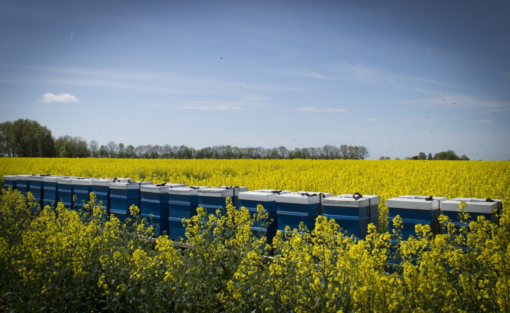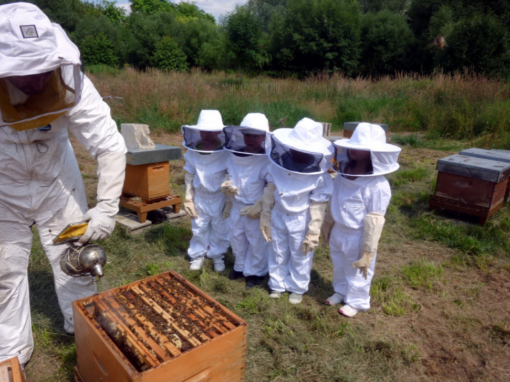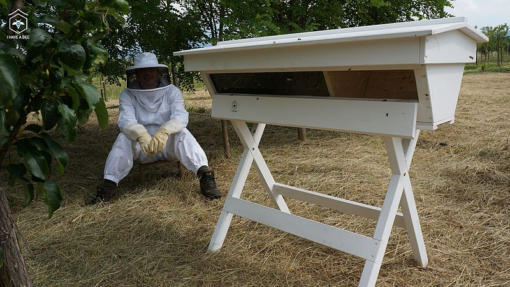In an earlier post, I talked about how and why I got into beekeeping (by accident). After a lot of research, now I’m going to share what I have learned about the different types of beehives, which type is the best option for me, and considerations for beekeeping in Alaska.
Types of Hives

When thinking back to my life before bees, I could only conjure up images of two types of hives: fields of tall grass and flowers with row upon row of Langstroth hives (image above); and Winnie the Pooh stealing honey from trees. However, in the world of beekeeping, there are a lot of different hive options! Langstroth, Top Bar, Warre, and so many additional creations from individuals crafting the perfect habitat for the bees in their areas. Below is a list of the top three types of hives by popularity.
Langstroth Hives

Starting out with seven shallow Langstroth boxes was intimidating, especially when I had no training and I was starting from scratch. I realized quickly that my boxes did not have tops or bottoms – both being necessary. As I researched building tops and bottoms, I also discovered that there are a lot (!!) of beekeeping companies scattered throughout the USA. It was thrilling to go to their websites and educate myself on what was needed to complete my setups.
Since receiving the boxes, I have immersed myself in so many books, YouTubes, and websites that I cannot recall where I learned that L.L. Langstroth is considered the father of American beehives. He figured out how to keep bees, rather than kill and raid their hives. Langstroth gave his life to the study of bees. He discovered “bee space” (yes, this is a real term). Bee space is the optimal space that bees enjoy to maximize comb production, which is 3/8 of an inch. Langstroth used this dimension and built frames and boxes around it. Hence, Langstroth hives! Langstroth hives account for the majority of hives used today, especially among new beekeepers and in the commercial beekeeping world.

Pros of the Langstroth Hive
- Foundation helps keep comb straighter (see above).
- Equipment is standardized for the most part, with 8 or 10 frames per box.
- All parts are easy to purchase nationally.
- Boxes are easily interchangeable.
- The frame appears to be the easiest for harvesting honey.
Cons of the Langstroth Hives
- The boxes can be very heavy when full of honey, some reports of 50-100 pounds per box!
- For those with back problems, inspections will be hard as most work requires stooping, bending, twisting, etc. over the box.
- In cold weather environments, like Alaska, these boxes need to be lifted off the ground – so building a stand for them is essential.
Top Bar Hives
Top bar hives are considered “natural” beekeeping. Most of the frames in these hives are foundation-less, letting the bees decide how to build their comb. When I asked around in the five or six Alaskan Facebook beekeeping groups, there are very few people using these hives types in Alaska, as the majority stick with Langstroth hives.

Pros of Top Bar Hives:
- For those with bad backs, there is essentially no bending over as the top bar is quite tall.
- No lifting heavy boxes to harvest honey because you’ll take one frame out at a time.
- The top swings up to open, mostly blocking the hive entrance, so fewer bees will be around while inspecting.
Cons of Top Bar Hives:
- Very few individuals in Alaska are keeping bees in this type of hive, so you’ll be experimenting mostly on your own.
- Because the frames are usually foundation-less, handling requires much more care upon inspection so that the comb is not damaged.
- Harvest means the whole comb is removed because there is no foundation, so uncapping is difficult.
- Conversely, many people love comb in their honey and it can be quite hard to find.
- Overwintering might be more difficult for the bees, because as heat rises the bees cannot move up as the hive is horizontal.
- Anecdotal discussions indicate this type of hive works better in the Lower 48, especially in warmer states.
Warre Hives
Warre (pronounced war-ray) hives, also known as “the people’s hive,” look nicer than Langstroth hives, they are smaller, easier to handle, and lighter. These boxes are a frameless set-up, allowing the bees to build their comb however they want. Being the opposite of the Langstroth system, the Warre process adds new boxes to the very bottom, rather than on top.
Emile Warre’s system of adding new boxes to the bottom is a process called nadiring. Although lifting a lot of boxes for inspections and harvesting honey might sound painful, the process of adding boxes is reportedly done about about once a year, in the springtime.

The thought is that as the top box fills with honey, it is removed and the bees move down, similar to a natural hive in a tree cavity. Since the lower box is already empty, the queen can start adding brood to that empty lower box. It is also believed to be healthier and cleaner because, as the beekeeper, you are removing the toxins and environmental contaminants from the top boxes more frequently, and the wax is not reused.
Pros of the Warre hive
- Less inspection of the hive needed.
- Only adding boxes at the beginning of the spring, then pulling honey in the fall.
- Foundation-less frames and cleaner comb, similar to top bar hive frames.
- Considered natural beekeeping.
Cons of the Warre hive
- Few people are using these boxes in Alaska, so you will be learning without an in-person mentor.
- Reportedly less honey production.
- Short season for honey in Alaska – pulling honey supers doesn’t seem to be conducive to overwintering.
Overall, these three hive systems seems to be the standards, but know that there are many different renditions of these boxes with variations on all of these, both vertically and horizontally. Once you begin researching hives, you’ll quickly realize that beekeepers are an amazing bunch of experimenters and those with differing ideas might start tinkering and testing to make the perfect hive for their specific environment.
Innovations
One excellent example of innovation is Vino Farm’s “bee barn” super insulated, double deep, Langstroth hives. This beekeeper’s northeast weather is similar to my weather in Anchorage, so my plan is to attempt to replicate his boxes before next winter, with high hopes for better overwintering odds. But, hey, there are so many options and opinions, my thoughts on this might be swayed when I head down the next hive-type rabbit hole – and there are a lot of rabbit holes in the world of beekeeping!
Through watching videos, visiting blogs and exploring all the innovation going on, I have discovered the world of beekeeping is very diverse and if you ask one question, you will get more opinions than you will know what to do with. Which is to say, beekeeping requires a lot of individual education, innovation, experimentation, and doing what is best for your bees, in your given area.
Next up: beekeeping gear
About Jamie Lang
Twitter •




